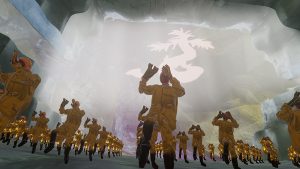There were a couple of interesting symposiums at the Japan Media Arts Festival that took place on February 24 and lasted till March 5 at Tokyo Metropolitan Museum of Photography.
One was titled “Fusion of Art and Technology” and the discussants included Hiroshi Harashima, Toshio Iwai, Kumiko Kushiyama, Masahiko Inakage and Katsushi Ikeuchi. So, they include both artists and technologists. First, Harashima talked about the history of art and science — how they were close with each other during Reneissance, then separated, and again there were some efforts to fuse them together. He argued that entertainment is a key factor in the recent efforts to marry technology and art. All discussants seemed to have agreed that art and technology are essentially inseparable. Iwai introduced the notebook (called Kousaku Book) he used when he was a kid. What was in the notebook suggested that his initial explorations were examples of art and technology blended together. Ikeuchi’s research project is about teaching robots the arts of dancing and drawing. Technologies are commonly used as tools and/or media for art, but Ikeuchi’s robot/AI approach (kind of like making artist robots) sounds unique.

[Device Art Symposium: Will Techno Gadgets become an art? From Japan Media Arts Festival blog]
The other symposium is titled “Device Art Symposium: Will Techno Gadgets become an art?” and the discussants included Machiko Kusahara, who was the organizer, Ryota Kuwakubo, Nobumichi Tosa (Meywa Denki), Kazuhiko Hachiya, and Hiroyuki Moriwaki. The main topics of this symposium are: Where is the border between art and pop culture? Is a “product” created by an artist “a piece of art”? Creators of “Device Art” who pursue the new relationship between art and technology work on the problem which media art cannot walk around.
Kusahara talked about historical examples mentioning Nishiki-e and craft products in Japan and how they became eventually sophisticated. Then, she argued such history is relevant to modern esthetic techno gadgets. Each discussant introduced his/her works and discussed the issues. One can view the works of Kuwakubo and Iwata as examples of an approach to intentionally de-emphasize artist’s messages and emphasize functionality. And it could appear paradoxical that such an approach may have led to wider acceptance of their works in the (media) art community.
Tosa made interesting comments about the Japanese “device art.” He doesn’t think it’s the best idea to make the world think that the Japanese culture is all about geeks and Akihabara. He views Japanese “device art” as something that comes after the “flat expressions” like Takashi Murakami’s Super Flat, and is grounded in [the tradition of] sophisticated craftwork and advanced digital technologies.







